“If you want to know if a guy is well dressed, look down.” So said US columnist George Frazier back in the 1950s, and his words have never been more true.
Men who spend too little on their shoes end up with flimsy things that look old from the first day they’re worn. But it’s not always easy to identify top craftsmanship.
The most important things in a shoe are the quality of the leather and the way the sole is attached.
Superior leather moulds to the foot, lasts a lot longer and looks great in the meantime. But it is becoming more expensive, particularly as a lot of the good calf leather is bought up by makers of luxury handbags.
The best way to assess it is to bend the shoe just below the laces, where the foot flexes, and look at how it creases.
“If the crease lines are small, it’s generally a sign of high quality,” says Jonathan Jones, managing director of Crockett & Jones. “Whereas coarser and larger creases indicate a lower grade of material.”
High-end English shoes in particular will always have this suppleness, such as Crockett’s handgrade line or those by Edward Green or Gaziano & Girling.
The sole of a shoe is a bit more complicated.
There are broadly three ways of attaching it: Goodyear welting, where a strip of leather is attached to the upper, and the sole sewn onto that; Blake stitching, where the sole is sewn directly onto the upper; and cementing, which is a fancy term for gluing.
Traditional English shoes are Goodyear welted. This is a slightly heavier construction, but longer lasting.
Most Italian shoes are Blake-stitched, because it is lighter and can be cut very close to the upper, so the sole is hardly visible. You can see the slimline effect of Blake stitching most clearly on shoes by brands like Berluti.
Cheaply made shoes – and slippers or light summer shoes – are cemented.
The choice between Goodyear and Blake is a personal one, but for an everyday shoe, I’d recommend starting with the former.
There are also several highly respected American makers of Goodyear shoes, such as Alden, and a few in Europe, a favourite being Corthay. The marque’s classic Arca style is a fine place to start, and comes in a range of colours from black to patent red.
The other advantage of English shoes is that price is still a pretty reliable guide to quality – unlike many European brands.
Many English makers are located around Northampton, use roughly the same techniques and spend relatively little on branding. The outliers are John Lobb (owned by Hermès) and Church’s (owned by Prada).
A more expensive English shoe generally means better materials and more handwork; in other geographies it could mean a lot of ornamentation or a bigger marketing budget.


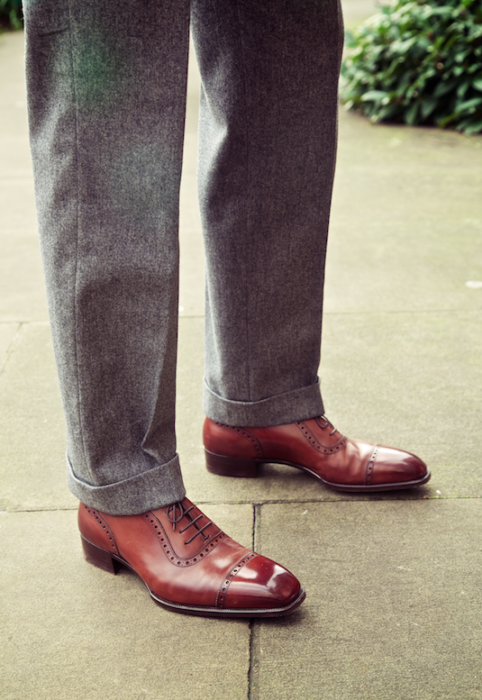
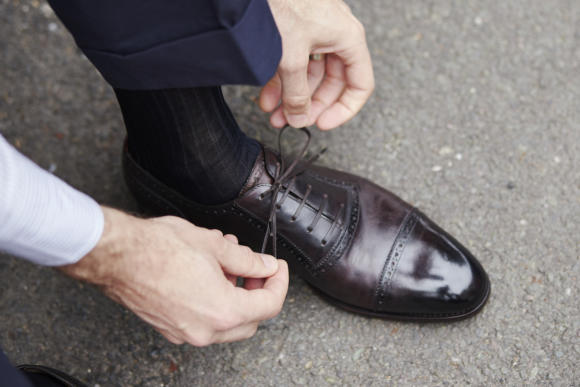
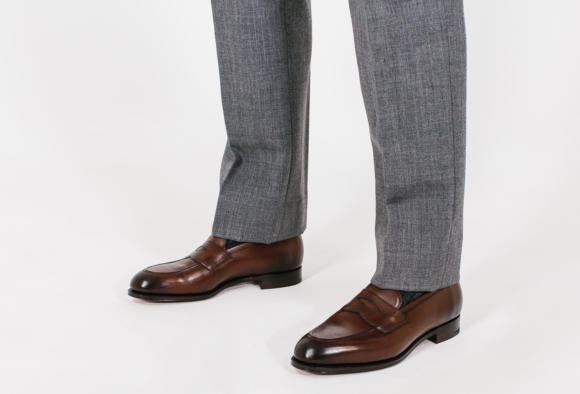
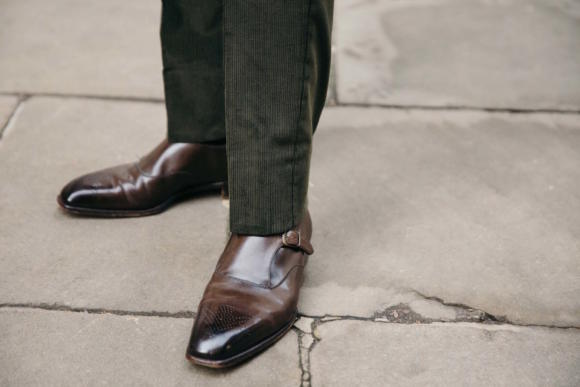
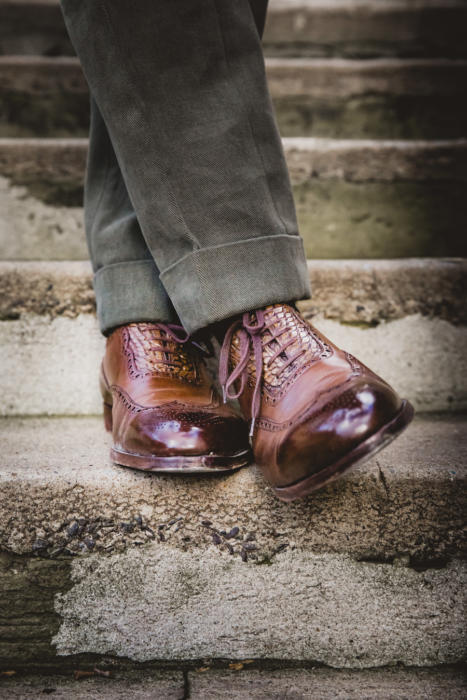


























I currently have two pairs of Church’s shoes and am contemplating another pair of ‘better’ shoes as an anniversary present. My wife would also like a quality pair of shoes but most of the better manufacturers appear to have limited ranges….except Grenson who has an extremely extensive range! I have read mixed reviews of Grenson, though some are quite old and may therefore be very out of date. I have also read your comments on the company which suggests this may be a good place to go. Do you know of any other companies who have extensive ladies ranges (my wife currently has two pairs of Clarks ‘brogues’ which she is very pleased with, but would like to step up) or is Grenson the place to start.
I’d recommend looking at Crocketts for women’s shoes. They have a nice range:
http://www.crockettandjones.com/collections/uk/ladies/all/all/all/all/all/all/all/all
Thank you very much, we’ll have a look.
Simon,
I have a pair of brown oxford cap-toe leather shoes with leather soles.
I believe the soles are becoming quite worn down, so I think it’s time they be replaced. In the past, when I have purchased boots with leather soles, I have replaced the leather with a dainite or rubber sole for more durability in poor weather.
My question is this: is there any advantage to having a leather sole on a dress shoe?
Is it worth replacing the soles of my dress shoes with leather again (over, say, dainite or rubber)? I don’t know if leather soles are more for aesthetics and/or comfort than anything else…?
Your thoughts, as always, are appreciated.
Thank you,
Eric
Leather will breathe, so it should keep your feet a little cooler, and it is pretty much always smarter. A leather sole can also be a thing of beauty, where a rubber sole never is. But these advantages are all small; if you get better wear with rubber there’s nothing wrong with it
May I ask the name of the shoes that are shown in the photo above the article? I think they look quite stunning.
Thank you
I’m afraid I don’t know – it’s been a long time. I believe they might have been from Crockett & Jones
Simon, if Maxwell means the first picture right at the top then I believe these are your bespoke G&G’s before they were repatinated.
You’re absolutely right, I’m sorry. I was getting mixed up with another article
Simon, you write: “High-end English shoes in particular will always have this suppleness, such as Crockett’s handgrade line or those by Edward Green or Gaziano & Girling.”
Do you mean the standard C&J line doesn’t and uses cheaper leather?
It certainly does than the latter two. And I think they say handgrade uses a slightly more select leather too
Hello Simon. As always, a wonderful post and thank you for your work. What are your thoughts on the color of the inner lining of shoes? Does the lining color make a difference in the overall aesthetic value or quality of a shoe (say, for example, a pair of black or dark brown captoe/whole cut Oxfords with tan lining compared to those shoes with black or dark brown inner lining)?
The lining colour doesn’t really make any difference to quality, and only a small one to aesthetics I think, given hardly anyone will ever see it.
Enjoyed this article… despite being English my preference is for Alden and vintage Florsheim. There’s something indefinable about both; I can’t quite put my finger on what that is but, for me, they have something that Grenson, Church’s et al don’t have. I was surprised at there being no mention of Shell Cordovan 🙂
I have a question about leather shoes. I know there are a few indicators of a well made shoe, (number of stitches per inch, shape of waist etc) however what are the indicators of good leather in a shoe? Aside from price and perhaps more obviously cheap shoes, how can one tell if the leather used to make the shoe is quality leather?
There are some things you can look for, like smaller, finer creases where the shoe bends. But that can also vary with thickness of type of leather, where one isn’t necessarily better or worse than the other. In the end, I would go off price. As I’ve said a few times, shoemakers pretty much give value for the price they charge, unless you’re buying from a different type of company, like a big brand. It’s more straightforward than tailoring because more shoemakers are actual makers, and are more similar types of companies (spending similar amounts on advertising, design, retail etc)
Thank you!
Simon, as I get older I start to feel it in the hips when I walk too often or too long in shoes with leather soles. Also I’d prefer if there was no sound when I walk.
Would could be done here?
Would Edward Greens “slim rubber sole” be a good alternative to leather soles? Do those soles wear down faster? Fixing is easy?
Hey,
Rubber soles do provide more softness than leather, yes, but it isn’t a big difference and I can’t say whether it will help your issue. I know it’s a different style, but something with a crepe sole, or just thicker rubber, might be better. Also, look at who has greater padding on the insole too – that will help just as much.
But yes, rubber soles can be replaced
Hi Simon, could I ask why you don’t seem that interested in John Lobb Paris RTW? Obviously, the brand is under big fashion house, and I am aware that you have a fairly strict standard for this, but I was wondering if there are any other reasons?
Many thanks,
Jack
Good question. I think it’s partly habit, in that I love wearing Edward Green and the two are pretty similar in terms of quality and style. And partly design-driven, in that I’ve never really seen things from Lobb that have made me want to try them instead.
I did try a pair of their boat shoes a few years ago, as that seemed interesting, being higher end materials than you’d normally get in that style, and not something EG would do. But I didn’t like the design as much and ended up selling them.
Thanks for the response, Simon. Interesting. Personally, I found John Lobb’s classic lines slightly more dressy than Edward Green’s, making it less versatile. lso, John Lobb’s waist part of the shoes are a little bit less sleek than Edward Green’s
Hi Simon, I bought a pair of oxford shoes a few weeks ago and noticed slight cracks on both sides of the heel packs (near the arch). Would you say this is a defect or something usual that I should ignore? I have attached a photo of the cracked area for your reference.
Many thanks,
Jack
That’s the point where the welt meets the heel, and is often an issue on cheaper makes. You see it with Alden all the time. I wouldn’t expect it on the more expensive brands you’ve been asking about recently though.
I see…
These are from Crockett&Jones’ Handgrade collections, and now I understand more specifically why you were saying even the hand grade is not at a similar level as the EG. Although the details are tiny, this kind of defect freaks me out, and this is a point where EG’s higher price(£350 difference) is justified.
Given your experience working with various top-end shoemakers, which tanneries would you say are the best?
To be honest Duke, I rely on the shoemakers for their recommendations and opinions, especially as grades from tanneries can vary substantially. I wouldn’t personally insist on a particular tannery over the shoemaker’s suggestion
Hi Simon,
I have a question, please. A local luxury department store is selling John Lobb (Paris) RTW shoes. The thing is that the shoes arent a model on JL’s website and while the price is still high, probably around 800 GBP, it is not as expensive as a pair of City II priced online. I’m not concerned about authenticity, but I am curious what the difference in price could mean about quality or range. Do you have any insights into this?
I think it’s unlikely it means anything about quality Simon – if they were seconds or something, they’d have to indicate that.
I’d imagine it’s just a special order by the store, and the price difference is mostly exchange rate or keen pricing by the store?